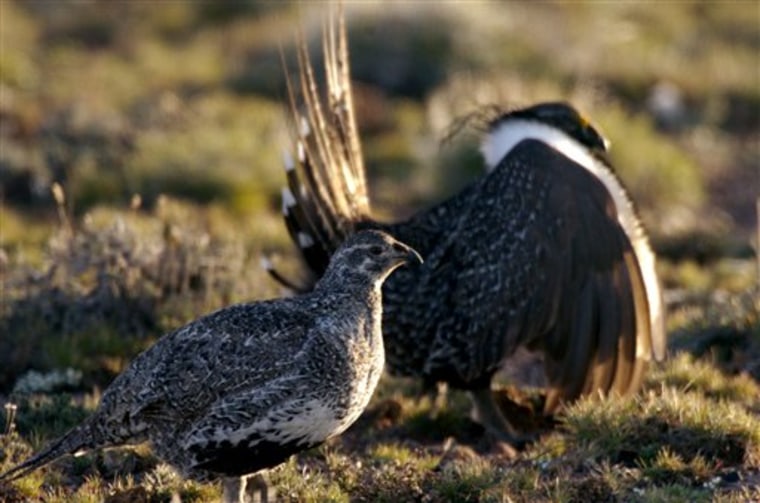The fate of basic industries across the Intermountain West — grazing, mining, energy — soon could be at least partially tied to that of a bird about the size of a chicken.
The federal government is under a judge's order to reconsider an earlier decision against listing the sage grouse as endangered, and wildlife biologists are scouring the species' customary mating grounds to see how many are left.
The species was seen as recently as 2004 over an area as large as California and Texas combined, but its habitat used to be close to twice that and research has shown that many types of human activity continue to harm it.
States and even some companies have made efforts to protect the sage grouse on their own, hoping to avoid a federal listing that could stretch across 11 states.
Bigger effect than spotted owl
The prospect of listing the species has drawn comparisons to the northern spotted owl, whose listing as a threatened species in 1990 drew the ire of logging interests in the Northwest.
But the grouse occupies several times as much land as the owl.
"It will affect everything we do and know (as) a Western state, everything from livestock grazing to mining to development of sage brush habitat, wind energy," said Ken Mayer, director of the Nevada wildlife department.
"I don't think we have ever been in this position before."
Ranchers and the oil and gas industry dodged stiff regulations in January 2005 when the government decided the bird didn't need to be listed as an endangered species.
But in December, U.S. District Judge B. Lynn Winmill in Boise overturned that decision by the U.S. Fish and Wildlife Service, partly because it was tainted by political pressure from Assistant Interior Secretary Julie MacDonald. She resigned last May amid questions about alleged interference in dozens of other endangered species decisions.
"Her tactics included everything from editing scientific conclusions to intimidating staffers," Winmill wrote.
State told to survey populations
The agency has until December to issue a new decision. It has given wildlife agencies in 11 states until June 24 to update information on local populations, the threat the sage grouse faces and the steps being taken to conserve them.
The grouse — mottled brown, black and white — is found on sagebrush plains and high desert from Colorado to California and north into southern Canada. Their courtship rituals, where males puff up bright yellow air sacks under their neck and fan out the pointy feathers in their tails, are imitated in dances of several American Indian tribes.
The birds return each spring to breeding and nesting locations called leks — generally high desert with sagebrush, grass and wildflowers that provide both food and cover from predators.
Wildfires, development and industry have steadily cut into that habitat.
"The last 17 years, more than 16 million acres have burned in the Great Basin," Assistant Interior Secretary Stephen Allred recently told the National Association of Conservation Districts.
Allred said 75 sage grouse leks were destroyed last summer in Idaho near the Nevada line by just one set of fires.
Half of habitat is gone
The sage grouse now occupy about half of their original, year-round habitat. The Fish and Wildlife Service estimated in 2005 there were 100,000 to 500,000 greater sage grouse.
The birds' reproductive and survival rates are also down in states hit hard by drought and invasive plants such as cheat grass, which elbow out sage brush and native grasses after fires. West Nile virus also is taking a toll.
In Nevada, for example, the numbers of chicks per hen hit a historic low of 0.58 last fall compared to a more typical figure of 1.8 to 2.0, said Shawn Espinosa, a wildlife biologist with the Nevada Department of Wildlife.
Biologists are quick to remind that grouse populations operate in cycles, but Espinosa said "the highs and lows are getting lower and lower and the overall trend of sage grouse population is going down."
Environmentalists who have been pushing for federal protection for more than a decade are convinced its population is on a path toward extinction.
An "honest assessment" of the bird's numbers and the threats it faces will show that it must be listed, said Katie Fite, director of biodiversity for the Idaho-based Western Watersheds Project, which sued the Fish and Wildlife Service over its 2005 decision.
"Unfortunately, in several Western states, efforts seem to be under way to be creative with grouse counting and mask how much numbers are down," she said. "Populations do sort of cycle, but part of the last upward trend was a result of agencies taking great pains to find and count grouse."
Private help for grouse
Pat Deibert, a Fish and Wildlife Service biologist based in Wyoming and the federal coordinator of the new review, said lek counts are up in her state and others report the same in parts of Oregon and Colorado thanks to recent rainy springs and the absence of significant wildfires.
But she said those areas may be the exception.
Since last fall, Wyoming has undertaken nearly two dozen projects to help grouse, including restoring habitat, purchasing easements on ranch lands, improving livestock grazing practices and researching ways to reduce the effects of oil and gas drilling.
"A number of individual companies have done conservation actions as well. Often they move well locations voluntarily to get out of a lek," said Cheryl Sorenson, vice president of the Petroleum Association of Wyoming in Casper.
"We did not want to even consider having this animal listed," she said.
